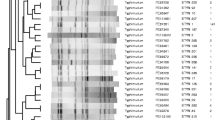Abstract
The diversity of Salmonella serotype Virchow organisms causing human salmonellosis in a Spanish region over 1990–1996 was studied by genetic and phenotypic procedures. Isolates showing identical DNA fingerprintings (ribotypes, RAPD-, REP- and ERIC-types) were clustered into the same lineage. Eight lineages were defined, of which only one caused diseases throughout the studied period. Eleven phage types (PTs) were represented, the most frequent being PTs 8, 19, 31, throughout the study period, and PT4a only during 1994. Class I integrons with variable regions of 1000-, 1600-, and 2300-bp in size were respectively present in 24, 3 and 5 multiresistant isolates; 43.5% of isolates were susceptible to antimicrobials, the rest were grouped into 17 R-profiles, including from one up to eight resistances. Plasmids could be recovered from 71.5% of isolates and grouped into 25 plasmid profiles (with 1–7 plasmids each); a 3.6 kb cryptic-plasmid and a 60 kb virulence-plasmid were those most frequently found. Phage type, presence and size of integrons, and resistance profile were used to differentiate 39 clones. During the period studied 135 cases of Virchow salmonellosis were identified; 93 were apparently sporadic whereas the remainder were associated with four outbreaks. Infants under 1 year constituted the most frequent age group, with 30 gastroenteritis and two septicaemia episodes. In the four outbreaks, different clones falling into the prevalent lineage were implicated but each clone was involved in only one outbreak.
Similar content being viewed by others
References
Sullivan AM, Ward LR, Rowe B, Woolcock JB, Cox JM. Phage types of Australian isolates of Salmonella enterica subsp. enterica serovar Virchow. Lett Appl Microbiol 1998; 27: 216-218.
Torre E, Threlfall EJ, Hampton MD, Ward LR, Gibert I, Rowe B. Characterization of Salmonella virchow phage types by plasmid profile and IS200 distribution. J Appl Bacteriol 1993; 75: 435-440.
Usera MA, Echeita A, Aladueña A, et al. Interregional foodborne salmonellosis outbreak due to powdered infant formula contaminated with lactose-fermenting Salmonella virchow. Eur J Epidemiol 1996; 12: 377-381.
Ruiz J, Núñez ML, Sempere MA, Díaz J, Gómez J. Systemic infections in three infants due to a lactose-fermenting strain of Salmonella virchow. Eur J Clin Microbiol Infect Dis 1995; 14: 454-456.
Usera MA, Rodriguez A, Echeita A, Cano R. Multiple analysis of foodborne outbreak caused by infant formula contaminated by an atypical Salmonella virchow strain. Eur J Clin Microbiol Infect Dis 1998; 27: 551-555.
Chambers RM, McAdam P, de Sa JDH, Ward LR, Rowe B. A phage-typing scheme for Salmonella virchow. FEMS Microbiol Lett 1987; 40: 155-157.
Guerra B, Landeras E, González-Hevia MA, Mendoza MC. A three-way ribotyping scheme for Salmonella serotype Typhimurium and its usefulness for phylogenetic and epidemiological purposes. J Med Microbiol 1997; 46: 307-313.
Landeras E, Mendoza MC. Evaluation of PCR-based methods and ribotyping performed with a mixture of PstI and SphI to differentiate strains of Salmonella serotype Enteritidis. J Med Microbiolol 1998; 47: 427-434.
Mendoza MC, Martín MC, González-Hevia MA. Usefulness of ribotyping in a molecular epidemiology study of shigellosis. Epidemiol Infect 1996; 116: 127-135.
Miyata M, Aoki T, Iglis V, Yoshida T, Endo M. RAPD analysis of Aeromonas salmonicida and Aeromonas hydrophila. J Appl Bacteriol 1995; 79: 181-185.
Martín MC, González-Hevia MA, Moro I, Mendoza MC. Genetic typing method applied to the differentiation of clonal lines among Salmonella enterica serogroup G strains causing human salmonellosis. FEMS Immunol Med Microbiol 1997; 19: 215-221.
Versalovic J, Koeuth T, Lupski JR. Distribution of repetitive DNA sequences in eubacteria and application to finger printing of bacterial genomes. Nuc Acids Res 1991; 24: 6823-6831.
Lévesque C, Piché L, Larose Ch, Roy PH. PCR mapping of integrons reveals several novel combinations of resistance genes. Antimicrob Agents Chem 1995; 39: 185-191.
Sambrook J, Fritsch EF, Maniatis T. Molecular Cloning: A Laboratory Manual, 2nd edn. Cold Spring Harbor Laboratory Press, Cold Spring Harbor, New York: 1989, Vol 1; 1.25-1.28.
Suzuki S, Komase K, Matsui H, et al. Virulence region of plasmid pNL2001 of Salmonella enteritidis. Microbiology 1994; 140: 1307-1318.
Mendoza MC, Landeras E. Molecular epidemiological methods for differentiation of Salmonella enterica serovar Enteritidis strains. In: Saeed AM, Gast RK, Potter ME, Wall PG (eds) Salmonella enterica Serovar Enteritidis in Humans and Animals. Epidemiology, Pathogenesis, and Control. Iowa: Iowa State University Press, Ames, 1999: 125-140.
National Committee for Clinical Laboratory Standards. Performance standards for antimicrobial disk susceptibility tests. Document M2–A5, 5th edn. National Committee for Clinical Laboratory standards, Villanova Pa. 1993.
National Committee for Clinical Laboratory Standards. Methods for dilution antimicrobial susceptibility tests for bacteria that grow aerobically, 2nd edn. Document M7–A2. National Committee for Clinical Laboratory standards, Villanova, Pa. 1990.
González-Hevia MA, Martín MC, Lobato MJ, Gutiérrez F, Solano P, Alvarez-Riesgo JA. Salmonella y salmonelosis en el Principado de Asturias durante un período de siete años (1990–1996). Enferm Infec Microbiol Clin 1999; 17: 166-170.
Olsen JE, Brown DJ, Skov MN, Christensen JP. Bacterial typing methods suitable for epidemiological analysis. Applications in investigations of salmonellosis among livestock. Vet Quarterly 1993; 15: 125-135.
Orskov F, Orskov I. Summary of a workshop on the clone concept epidemiology, taxonomy and evolution of the Enterobacteriaceae and other bacteria. J Infect Dis 1993; 148: 346-357.
Author information
Authors and Affiliations
Rights and permissions
About this article
Cite this article
Martín, M., González-Hevia, M., Alvarez-Riesgo, J. et al. Salmonella serotype Virchow causing salmonellosis in a Spanish region. Characterization and survey of clones by DNA fingerprinting, phage typing and antimicrobial resistance. Eur J Epidemiol 17, 31–40 (2001). https://doi.org/10.1023/A:1010980715351
Issue Date:
DOI: https://doi.org/10.1023/A:1010980715351



